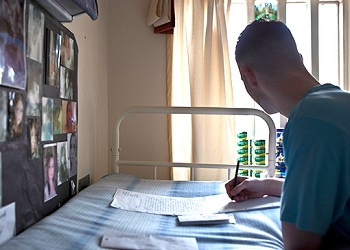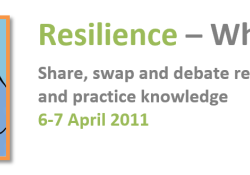Boingboing blogs from… the Resilience Forum!
Trauma informed approaches to families and justice in the United States – Sam Hart, Sussex Prisoners’ Families, Brighton Resilience Forum – Tuesday 14 June 2016
by Mandie Shean, Boingboinger
Your blog writer today is all the way from Edith Cowan University in Perth, Western Australia. My background is in education and psychology and my PhD was on resilience in Australian adolescents. I have arrived in Brighton to spend seven weeks with the Boingboing team at the University of Brighton. I came here to learn everything I can about the practical application of resilience and I am very grateful to Angie Hart and her team for letting me follow them around and learn.
Today I had the opportunity to attend a Resilience Forum with Sam Hart where she shared her knowledge and understanding of trauma and incarcerated individuals. Sam’s insights were based on her prior experiences and her trip to the United States of America (USA) through the Winston Churchill Memorial Trust Fellowship. Her focus for her scholarship was families of incarcerated individuals, however during her time in the USA the term “trauma informed lens” was referred to frequently, so she changed her focus to this.
Sam discussed the concept of trauma as experiences or situations that are emotionally painful and distressing, and that overwhelm people’s ability to cope. A trauma informed approach uses the principles of empowerment, collaboration, peer support, safety and cultural awareness to support the person who has experienced trauma. This takes the position that someone is not sick but injured, or as one of the participants stated: “Nothing is wrong with me. Something happened to me. They should ask me about that.” A trauma informed approach works with individuals to develop their capacity in the midst of their traumatic experience.
Trauma is evident in families of incarcerated individuals. They face issues associated with the arrest, court (shocked, confused, exposed, loss), and prison experience (separation, visiting, travel, anxiety). For example, some families are awoken to arresting officers who then search the house and go through all of their things. Anxiety can be created by news headlines in papers reporting the violence and danger of jails, increasing the perception of imminent danger. Additionally, some families need to travel three hours to visit their incarcerated family member which add further stress around the incarceration experience.
Even after the prison term has finished, families of the previously incarcerated person can have issues around the release (broken relationships, similar behaviours as prior to incarceration), and some have no preparation for the release. What will it look like? How will things work? All of these events – from the arrest through to the release – can create collateral damage to the family of the incarcerated person.
The impact of incarceration on family members is evident in research, with studies indicating that children of incarcerated parents are two to three times more likely to experience mental health issues. The Adverse Childhood Experience Study (ACE) by Felitti and Anda (1998) also provides evidence, with incarceration of a family member ranking as one of the top ten risks for children in childhood. According to a stress model, incarceration of a family member results in chronic stress. Chronic stress is damaging as it is related to a reduction in working memory and learning, increased negative emotional responses, decreased immune system responsiveness, and an increase in risky behaviours.
Sam stated that you need a “root and branch” reform to have a trauma informed approach. That is, you need to change the system as well as empower the individuals who are experiencing the trauma. One group in the USA who implemented a root and branch trauma informed response was “Project WHAT!” in San Francisco. In their project they engaged young people to tell their story, trained them in public speaking, and gained a commitment from them to share their story with other children of incarcerated parents. Through this project they have been able to better understand the needs of children of incarcerated parents. For example there are now key recommendations around the support these children need, barriers to service provision, appropriate services, and how the incarceration affects their school work.
This approach also informed current arrest procedures in San Francisco. An extensive list of initiatives were put forward and some have already been achieved. Some of the suggestions included training officers in child development so they understand how to relate to young people during the arrest process. They also taught them face saving measures for adolescents so they did not back them into a corner and create a worse problem for the teen. Other suggestions included not arresting when there were signs of a child in the house, giving parents the chance to say goodbye, and allowing parents to explain to the child what was happening.
In the Resilience Forum there was discussion around whether these measures were just “good practice” and why they should need to be “taught”. One member of the Forum indicated that officers may be similar to other professions in that they are doing a task (arresting someone) and not considering the process (look after the humanity in the situation). However, others commented on the danger of the situation and the difficulty officers would have in guaranteeing their own safety, completing the “task” of arrest, and at the same time ensuring the children in the house were looked after in the process. This displays the importance of considering all sides in the discussion.
There was also discussion about using a trauma lens, and whether this was medicalising and pathologising the experience. That is, not all individuals who have a family member incarcerated experience trauma. Possibly, looking at the situation through a resilience lens may provide a different perspective. We could better understand their strengths and work with these to increase capacity and resilience. Whatever lens is chosen, some children whose parents are incarcerated are traumatised by the experience. This experience can lead to long-term negative mental health outcomes for the child.
Sam finished the Forum with a discussion of the concepts of having power and being powerless. These are critical concepts to consider, because these ideas relate to the root and branch idea whereby the system and the individual need to be addressed. A system responsive to young people will be set up to empower the child to make resilient moves. Through resilience interventions young people may be able to improve their own lives and the system around them by understanding possible resilient moves. Young people can also be empowered, rather than powerless, through system change (the processes officers engage in during the different stages of arrest, court, prison, and release).
Similar to the project in San Francisco, and here at Boingboing at the University of Brighton, a trauma informed approach starts by giving young people directly affected by trauma a voice. In this way their experiences are understood and this can be the start of effective and meaningful system and individual change, whereby the young person can develop resilient moves that are directly relevant to them.


